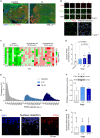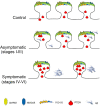Aberrant Synaptic PTEN in Symptomatic Alzheimer's Patients May Link Synaptic Depression to Network Failure
- PMID: 34045952
- PMCID: PMC8144462
- DOI: 10.3389/fnsyn.2021.683290
Aberrant Synaptic PTEN in Symptomatic Alzheimer's Patients May Link Synaptic Depression to Network Failure
Abstract
In Alzheimer's disease (AD), Amyloid β (Aβ) impairs synaptic function by inhibiting long-term potentiation (LTP), and by facilitating long-term depression (LTD). There is now evidence from AD models that Aβ provokes this shift toward synaptic depression by triggering the access to and accumulation of PTEN in the postsynaptic terminal of hippocampal neurons. Here we quantified the PTEN in 196,138 individual excitatory dentate gyrus synapses from AD patients at different stages of the disease and from controls with no neuropathological findings. We detected a gradual increase of synaptic PTEN in AD brains as the disease progresses, in conjunction with a significant decrease in synaptic density. The synapses that remain in symptomatic AD patients are more likely to be smaller and exhibit fewer AMPA receptors (AMPARs). Hence, a high Aβ load appears to strongly compromise human hippocampal synapses, as reflected by an increase in PTEN, inducing a loss of AMPARs that may eventually provoke synaptic failure and loss.
Keywords: PSD-95; cognition; hippocampus; human; plasticity; synaptosomes.
Copyright © 2021 Díaz González, Buberman, Morales, Ferrer and Knafo.
Conflict of interest statement
The authors declare that the research was conducted in the absence of any commercial or financial relationships that could be construed as a potential conflict of interest.
Figures





Similar articles
-
Non-fibrillar beta-amyloid abates spike-timing-dependent synaptic potentiation at excitatory synapses in layer 2/3 of the neocortex by targeting postsynaptic AMPA receptors.Eur J Neurosci. 2006 Apr;23(8):2035-47. doi: 10.1111/j.1460-9568.2006.04733.x. Eur J Neurosci. 2006. PMID: 16630051
-
Enhancement of long-term depression by soluble amyloid β protein in rat hippocampus is mediated by metabotropic glutamate receptor and involves activation of p38MAPK, STEP and caspase-3.Neuroscience. 2013 Dec 3;253:435-43. doi: 10.1016/j.neuroscience.2013.08.054. Epub 2013 Sep 5. Neuroscience. 2013. PMID: 24012839
-
The effect of chronic stimulation of serotonin receptor type 7 on recognition, passive avoidance memory, hippocampal long-term potentiation, and neuronal apoptosis in the amyloid β protein treated rat.Psychopharmacology (Berl). 2018 May;235(5):1513-1525. doi: 10.1007/s00213-018-4862-3. Epub 2018 Apr 10. Psychopharmacology (Berl). 2018. PMID: 29637287
-
Oligomeric Aβ-induced synaptic dysfunction in Alzheimer's disease.Mol Neurodegener. 2014 Nov 14;9:48. doi: 10.1186/1750-1326-9-48. Mol Neurodegener. 2014. PMID: 25394486 Free PMC article. Review.
-
Role of Aβ in Alzheimer's-related synaptic dysfunction.Front Cell Dev Biol. 2022 Aug 26;10:964075. doi: 10.3389/fcell.2022.964075. eCollection 2022. Front Cell Dev Biol. 2022. PMID: 36092715 Free PMC article. Review.
Cited by
-
Differential Effects of APOE Genotype on MicroRNA Cargo of Cerebrospinal Fluid Extracellular Vesicles in Females With Alzheimer's Disease Compared to Males.Front Cell Dev Biol. 2022 Apr 27;10:864022. doi: 10.3389/fcell.2022.864022. eCollection 2022. Front Cell Dev Biol. 2022. PMID: 35573689 Free PMC article.
-
Neuronal Stem Cells from Late-Onset Alzheimer Patients Show Altered Regulation of Sirtuin 1 Depending on Apolipoprotein E Indicating Disturbed Stem Cell Plasticity.Mol Neurobiol. 2024 Mar;61(3):1562-1579. doi: 10.1007/s12035-023-03633-z. Epub 2023 Sep 20. Mol Neurobiol. 2024. PMID: 37728850 Free PMC article.
References
LinkOut - more resources
Full Text Sources
Other Literature Sources
Research Materials

